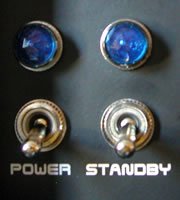Does The Use of Standby Switch Help Valve Life?
If you own a valve guitar amplifier you will almost certainly have a standby switch on it.
Recei ved wisdom has it that the standby switch is there to protect the amplifier output valves.
ved wisdom has it that the standby switch is there to protect the amplifier output valves.
Aside: your guitar amplifier has two sorts of valve – preamplifier valves (the smaller ones) and amplifier output valves (the larger ones which do the ‘heavy lifting’).
You’ve probably been taught to protect the amplifier output valves by leaving the amplifier in STANDBY whilst it warms up, then switching the standby switch to ON after a minute or so. In some vague, unspecified way, this is supposed to protect the amplifier output valves, right?
But is it true or is it a myth? Are amplifier output valves protected (e.g. last longer) by holding off applying HT to them?
Amplifier Output Valves – Longer Life, or not?
This is a really curious and controversial story. To begin with, in case you didn’t know, all the standby switch does is turn off/on the HT (high voltage) supply to the amplifier output valves. It doesn’t affect the valve heaters or any other part of the circuit. So if nothing else it is a useful ‘mute’ switch!
But is it more than that? After all, there are probably easier ways of achieving the mute function other than switching the 500V line!
For decades guitarists have faithfully powered up their valve guitar amplifiers in the following order (in the belief that their guitar amplifier output valves will have an extended life):
- Turn on the mains power.
- Wait a minute or so for the amplifier output valves to warm up.
- Turn the standby switch on, thereby apply HT to the amplifier output valves .
Why have they done that?
Guitarists fall into two camps:
- “Dunno. I just do what I’m told.”
- “It’s…er… to prevent cathode stripping of the amplifier output valves … or something … isn’t it?”
It is this last point which is the most interesting. Rumour has it that turning on the HT as the amplifier output valves warm up causes something called ‘cathode stripping’.
Sounds bad? It apparently shortens the life of the amplifier output valves as all that ‘stuff’ is stripped off the cathode.
But Is it True?
Not true, apparently! Some very authoritative sources (top valve engineers who know their way around a differential equation) say this is a carried forward error from the days of (very) large radio transmitter amplifier output valves which DID suffer from this if they were not warmed up properly prior to the application of HT.
Apparently this is NOT true of the amplifier output valves used in audio (e.g. guitar) amplifiers!
Interestingly you can’t get a straight answer out of Marshall, Fender et al. regarding the extension of the life of amplifier output valves using this sequence. They will simply intone the mantra that it’s ‘best’ to follow their laid down sequence. Some say they would be really embarrassed to admit they had got it wrong for the last 50 years and that there was NO lifetime improvement of your amplifier output valves!
So what to do?
If you habitually follow the sequence above then carry on as it certainly won’t hurt, and neither will it extend the life of your amplifier output valves. But word is out that it makes no difference, you can turn the power and standby switches on/off together!
By the way you NEVER have to go into standby before turning the power OFF, and you never did. Just go ahead and kill the power when you’re done. It certainly won’t hurt to put it in standby first, of course. But none of this will have any effect on the life span of your amplifier output valves.
Valve amplifier reviews will rarely, if ever, mention this subject.


